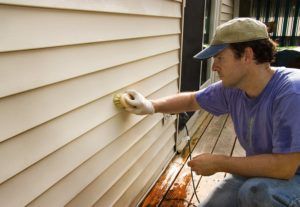 Over the years, siding has evolved and changed to meet the needs of homeowners and take advantage of improved technologies in the marketplace. Wood siding hasn’t changed much over the years, but products such as fiber cement siding by James Hardie have gained popularity for their good looks and durability. In recent years, however, there have been increasing problems with siding succumbing to damage from high heat caused by reflections from some kinds of low-e and energy efficient windows. This is a recent problem that was practically unheard of before the latest coated windows hit the market. There has also been increasing interest in finding siding that can protect homes located in areas with a high risk of forest fires or wild fires. Due to these fires, some fire departments have urged homeowners to choose non-flammable materials like fiber cement.
Over the years, siding has evolved and changed to meet the needs of homeowners and take advantage of improved technologies in the marketplace. Wood siding hasn’t changed much over the years, but products such as fiber cement siding by James Hardie have gained popularity for their good looks and durability. In recent years, however, there have been increasing problems with siding succumbing to damage from high heat caused by reflections from some kinds of low-e and energy efficient windows. This is a recent problem that was practically unheard of before the latest coated windows hit the market. There has also been increasing interest in finding siding that can protect homes located in areas with a high risk of forest fires or wild fires. Due to these fires, some fire departments have urged homeowners to choose non-flammable materials like fiber cement.
Why Wood Siding May Be Dangerous
The beautiful look of wood is appealing, but it is extremely flammable and can quickly catch fire and even burst into flame when exposed to the intense heat of wild fires. Several cases of cedar siding being scorched or burned by high temperatures from reflected light off of energy efficient windows have also been reported. It’s pretty obvious that if you want a home that is relatively safe from fire or heat, installing siding isn’t the answer.

Only high-quality materials from trusted manufacturers when handling siding installation
How Vinyl Siding Stacks Up
Despite manufacturers’ efforts to create vinyl siding for homes that can tolerate high temperatures, PVC vinyl simply can’t take excessive temperatures, with the cut-off being about 165° Fahrenheit. Unfortunately, UV reflective windows aren’t the only things that can send temperatures soaring near your vinyl siding. Heat from a grill placed too close to an exterior wall, backyard fire pits, or fire from a neighboring house can all cause damage that siding contractors won’t be able to fix. In most cases, warranties don’t cover any damage from excessive heat, leaving you to pay for replacement or repairs yourself.
Fiber Cement By James Hardie: Homes Can Be Protected From Heat Damage
Fiber cement siding by James Hardie is popular with homeowners for many reasons, including its good looks and long life. It resembles genuine wood more closely than any other siding material and lasts for up to 50 years because it is made of sand, silica and Portland cement. The components it is made of also make James Hardie the most heat-resistant siding material. There have been many cases where homes right next door to a fiber cement house have burned to the ground while the house by James Hardie was unscathed. You may never have to cope with a wild fire, forest fire or even damage from reflected light from neighboring homes, but if you do, you’ll be glad that our siding contractors covered your home in fiber cement siding by James Hardie. Homeowners are savvy shoppers. They understand that the right material for their homes has to offer more than good looks. By choosing fiber cement siding, you’re placing their confidence in one of the finest siding materials on the market. It’s durable, wears like iron, lasts for years and is extremely heat resistant so that you can worry less and enjoy your house more.


